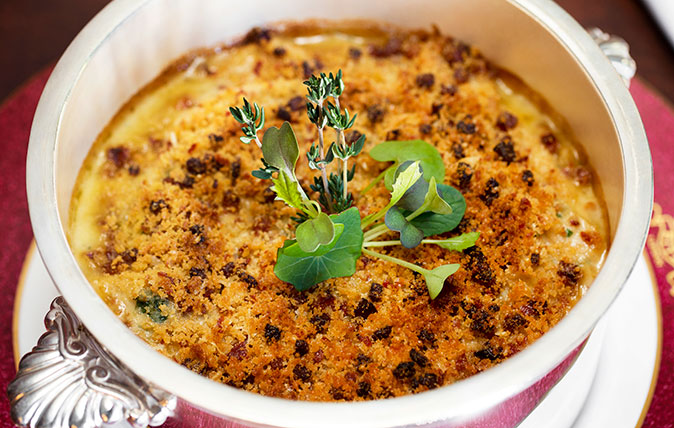Clear some shelf space because Country Life’s resident chef Simon Hopkinson, author of the award-winning Roast Chicken and Other Stories, has picked his all-time favourite cookbooks and their standout recipes.
It’s such a pleasure to be asked by the Editor of Country Life to name my 10 most favourite cookery books. Usually, when asked for ‘favourite’ anythings, it is in the singular, which is an appalling request.
The following list is a mixture of books both current and of the past: the former, almost accidentally, thrilling and vital and the latter, lovingly, remaining forever set in stone. I never expect others to necessarily agree with my choice, but I very much hope that any book found here that pleases my readers will be happily used.
The French Menu Cookbook (1970) by Richard Olney 
Make no mistake, this is a serious textbook. For those who wish to embrace the (perhaps lost) lore of fine French cooking, here is a revelation for the bold young cooks of today who are both bright and worth their salt. A precise description of how to achieve a clear broth or a discussion of the importance of a mirepoix, say, are here.
Standout recipe
Olney’s Terrine of Poultry Livers gives instructions that are rarely seen today: ‘Combine all the ingredients in a large mixing bowl, working them thoroughly together with both hands, squeezing the mixture repeatedly, through clutching fingers, until completely homogenous.’ Clear. Obvious.
Great Chefs of France (1978) by Quentin Crewe and Anthony Blake (photographs)

The day I bought this from Hatchards in Piccadilly, in 1978, I took it home and read it from cover to cover, in bed, without pause. Never before had a book been compiled so luxuriously, so informatively. Nor, notably, with such ravishing photography. I recently bought a copy for a young chef whom I admire. I hope he’ll have a sleepless night, too.
Standout recipe
‘Reduce the sauce to which has been added the cooking liquor of crayfish and cream. Strain.’ This quote is attached to deeply evocative pictures, in which two chefs are straining a shellfish sauce through a large sheet of muslin, twisting it over a bowl until only the very smoothest drip results.
An Omelette and a Glass of Wine (1984) by Elizabeth David

My fondness for this, of all Elizabeth’s books, may be biased by the beginning of a friendship with her that followed soon after its publication in 1984. However, I remain particularly devoted, as it’s a compil-ation of essays, previously unpublished work and pithy 1960s articles from The Spectator and Vogue, among others. It is unique. It’s also personally signed.
Standout recipe
‘A sauce for boiled lobster’, dit ‘Courchamps’, and ‘Grillades des mariniers du Rhône’. The first is an astonishing dressing scented by aniseed. The second is a succulent braise of beef and onions, with only a splash of vinegar as liquid.
Cooking in Ten Minutes (1930) by Edouard de Pomiane

In 1930, it was clear that Edouard de Pomiane knew more about ‘quick and easy recipes’ than anyone who might misuse that epithet today. Brief of description (present-day ‘fast’ cook’s recipes seem curiously wordy), intelligently precise and wonderfully witty. Although one must know how to cook, it remains an easy list. Elizabeth David was one of his most ardent admirers.
Standout recipe
‘Fry some chipolata sausages. Serve very hot on a dish and on a second dish a dozen oysters. Alternate the sensations: Burn your mouth with a crackling sausage. Soothe your burns with a cool oyster. Continue until all the sausages and oysters have disappeared.’
The Good Food Guide Dinner Party Book (1971) by The Consumers’ Association
The first book of its kind (it was published in 1971) to offer its Guide readers an insight into the recipes of some of the most beloved restaurants in Britain. For me, as a boy-cook ready for all that could be thrown at him, it was a revelation. Elegantly presented and expertly edited. Occasional sketches, but not illustrated. A seminal collection.
Standout recipe
A recipe for Sticky Toffee Pudding, given by a Mrs Martin, of Claughton, Lancashire. Today, some call sticky toffee pudding their own and claim a glorious heritage of making it that goes back 25 years. The inconvenient truth is that 1971 is 47 years ago.
A Long and Messy Business (2018) by Rowley Leigh

I was introduced to Rowley Leigh by a fellow cook in 1983. Immediately, I knew that we would get on. We spoke the same language, with a deep love of food, a healthy greed and, significantly, we both treasured the joy of a timeless recipe.
Possessed of a bright intellect, pitch-perfect prose and the occasional, self-deprecating aside, Rowley has compiled a masterful collection. Rare stuff.
Standout recipe
It’s a joy to choose a recipe that both Rowley and I have long considered with a rather long nose: Paul Bocuse’s pumpkin soup. The original instruct-ion insists that the dish be fashioned from scratch within a hollowed-out pumpkin. It doesn’t really work – and that doesn’t really matter.
Traditional Puddings (1983) by Sara Paston-Williams

The book was published by the National Trust, as befits its properties’ wealth of mouth-watering tea rooms. Sara Paston-Williams’s list of favourite puddings – from nursery to regional British treasures – offers the historical and curious, as well as stimulating the greedy. It’s delightfully written, with both style and a keen knowledge. For the persistently cosseted and sweet-toothed.
Standout recipe
When I visited The Bakewell Pudding shop in Bakewell, Derbyshire, I was astonished by quite how different the pudding was to the now ubiquitous tart – the latter seems a poor cousin. The Rich Bakewell Pudding is a revelation.
You’re All Invited (2012) by Margot Henderson

Margot Henderson (wife of Fergus) is unlike any other cook I have ever known. She’s an exceptionally gifted cook who just knows and, further, understands that it’s as important to know how to make a negroni (‘Listen for the negroni roar!’, page 261) as to simply roast a quail. Her book is not only useful, it’s a joy to read.
Standout recipe
Something that will definitely delight: Soft Buns. In recent years, this has emerged as one of my most favourite bread recipes. Furthermore, the buns are also very simple to make; brioche-like, but not as rich. They’re very good baked as a small loaf, too.
Cuisine Gourmande (1978) by Michel Guérard
Although Guérard’s first book, Cuisine Minceur (1976), made his name, it was his second, Cuisine Gourmande (1978), that excited us budding cooks at the time. The dishes were staggering in their originality: so new to us all, so clever, so expert. Nothing has come close, even to this day, to providing inspiration to a young cook so greedy for knowledge.
Standout recipe
Although a savoury mousse may seem a touch passé in the kitchens of hipster cooks today who like to burn and smoke, the traditional French quenelle, transformed by Guérard as a ‘scallop mousseline’, can crush the boisterous simply by its trembling texture.
Foods from the Far East (1990) by Bruce Cost

In the early 1990s, I was introduced to Bruce Cost when staying with Ken Hom in San Francisco. Ken had suggested we go to eat at Bruce’s restaurant Monsoon. ‘Simon, I think you will like it,’ said Ken, his quiet voice, as ever, suggesting a touch more than that. It was a revelation, of course. A sharp shock of how East could, sublimely, combine with West.
Standout recipe
Although one of the recipes in Bruce’s book inspired one of my earliest ways with the aubergine – his ‘sautéed aubergine with black vinegar’ – I am, today, more moved towards his flights of fancy. A recently made duck-liver mousse in a poultry consommé is ethereal. ‘The day I bought this, in 1978, I read it from cover to cover, in bed, without pause’.

The best books to give this Christmas
Emily Rhodes suggests eight books that would make the ideal literary stocking filler.

Jason Goodwin: ‘Every housewife used to have a notebook in the kitchen, battered and splattered, its pages scribbled over’
Roped into a speaking at a literary festival at the 11th hour, Jason Goodwin reminisces about the old cookbooks his

How to cook The Prince of Wales’ favourite dish: Pheasant Crumble Pie
See how to make the Prince of Wales's favourite dish, pheasant crumble pie, as demonstrated by John Williams, executive chef






